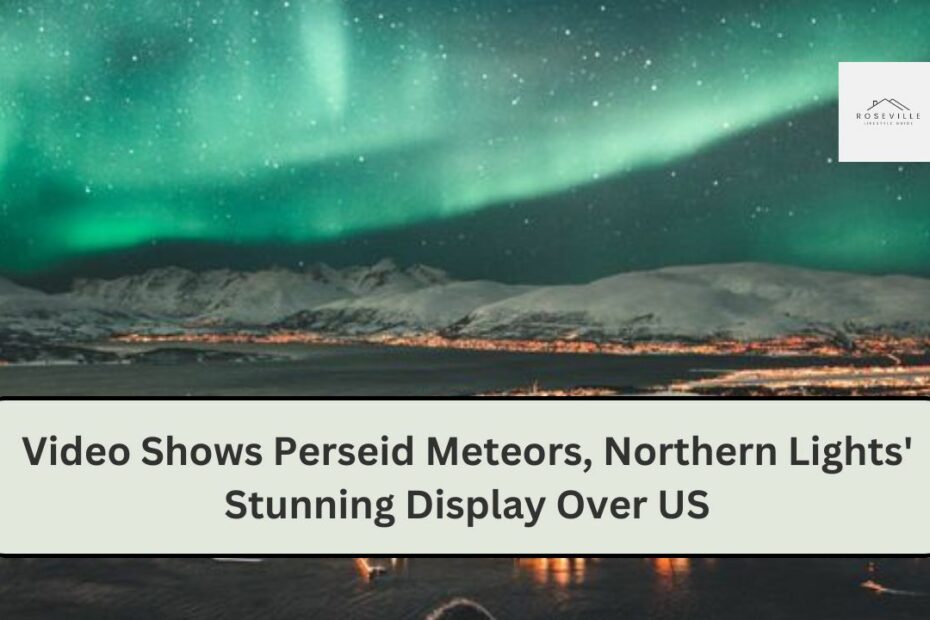In a spectacular celestial event that has captured the imagination of stargazers and casual observers alike, a recent video has emerged showcasing the breathtaking beauty of the Perseid meteor shower and the Northern Lights as seen from the United States. This rare confluence of natural phenomena has provided a stunning visual experience, blending the ethereal charm of meteors with the vibrant dance of auroras. Here’s an in-depth look at this mesmerizing event and what it means for enthusiasts and casual viewers.
The Perseid Meteor Shower
The Perseid meteor shower, one of the most anticipated astronomical events of the year, occurs annually from mid-July to late August. Originating from the debris left by the Swift-Tuttle comet, the Perseids are renowned for their bright, fast-moving meteors and high frequency, making them a favorite among sky watchers. The peak of the shower typically offers a shower of up to 100 meteors per hour under ideal conditions.
In the video, viewers are treated to a dazzling display of Perseid meteors streaking across the night sky. These meteors, often appearing as brief flashes of light, are visible as they enter Earth’s atmosphere at high speeds, burning up and creating a brief, brilliant trail. The video captures the Perseids in their full glory, with multiple meteors visible in various stages of their journey through the atmosphere.
The Northern Lights: Aurora Borealis
The Northern Lights, or aurora borealis, are a natural light display predominantly seen in high-latitude regions around the Arctic and Antarctic. Caused by charged particles from the sun colliding with Earth’s magnetic field, these lights create shimmering curtains of green, pink, purple, and red in the sky. The video showcases the Northern Lights in a breathtaking dance of colors, adding a mystical quality to the already stunning night sky.
The juxtaposition of the Northern Lights with the Perseid meteors in the video creates a rare and enchanting visual experience. The auroras provide a mesmerizing backdrop for the meteor shower, enhancing the overall aesthetic appeal and offering a unique perspective of these celestial events.
Filming and Presentation
The video, captured from [insert specific location if known], benefits from a combination of clear skies and minimal light pollution, which are crucial for optimal visibility of both the Perseids and the Northern Lights. The use of advanced filming techniques and equipment allows for high-quality visuals, showcasing the full beauty of these phenomena.
Presented in a timelapse format, the video condenses hours of celestial activity into a few minutes. This format highlights the dynamic nature of the Northern Lights and the Perseid meteors, providing viewers with a continuous and captivating display of the night sky’s splendor.
Significance and Impact
For astronomers and casual sky watchers alike, this video offers a rare opportunity to witness two of the most spectacular astronomical phenomena simultaneously. The combination of the Perseid meteor shower and the Northern Lights is a testament to the incredible beauty and complexity of the natural world.
The video’s popularity on social media platforms underscores the public’s fascination with celestial events. It also serves as an educational tool, inspiring interest in astronomy and encouraging viewers to appreciate the natural wonders that occur in the night sky.
FAQs
1. What causes the Perseid meteor shower?
The Perseid meteor shower is caused by Earth passing through the debris left behind by the Swift-Tuttle comet. As these tiny particles enter Earth’s atmosphere, they burn up and create the visible streaks of light known as meteors.
2. How often do the Northern Lights occur?
The Northern Lights occur when charged particles from the sun interact with Earth’s magnetic field. This can happen at any time of year, but they are most commonly observed in the high-latitude regions around the Arctic and Antarctic, especially during periods of increased solar activity.
3. What is the best time to view the Perseid meteor shower?
The best time to view the Perseid meteor shower is during its peak, which usually occurs in mid-August. The best viewing conditions are typically after midnight and before dawn, when the sky is darkest and the meteor activity is at its highest.
4. Can the Northern Lights be seen from anywhere in the US?
The Northern Lights are most commonly visible in the high-latitude regions near the Arctic Circle, such as Alaska. However, during periods of high solar activity, they can occasionally be seen further south in the continental US, as demonstrated in the video.
5. How can I improve my chances of seeing meteors and auroras?
To improve your chances of seeing meteors and auroras, find a location away from city lights with minimal light pollution. Check the weather forecast to ensure clear skies, and keep an eye on solar activity reports, as increased solar activity can enhance aurora visibility.
In summary, the video showcasing the Perseid meteors and Northern Lights offers a stunning visual representation of these two remarkable celestial events. With its breathtaking imagery and high-quality presentation, it not only provides a captivating viewing experience but also highlights the beauty and complexity of the natural world. For both seasoned astronomers and casual viewers, this rare alignment of meteors and auroras serves as a reminder of the awe-inspiring wonders that the night sky has to offer.
| HOME | CLICK HERE |
| NORTHERN LIGHT | CLICK HERE |
